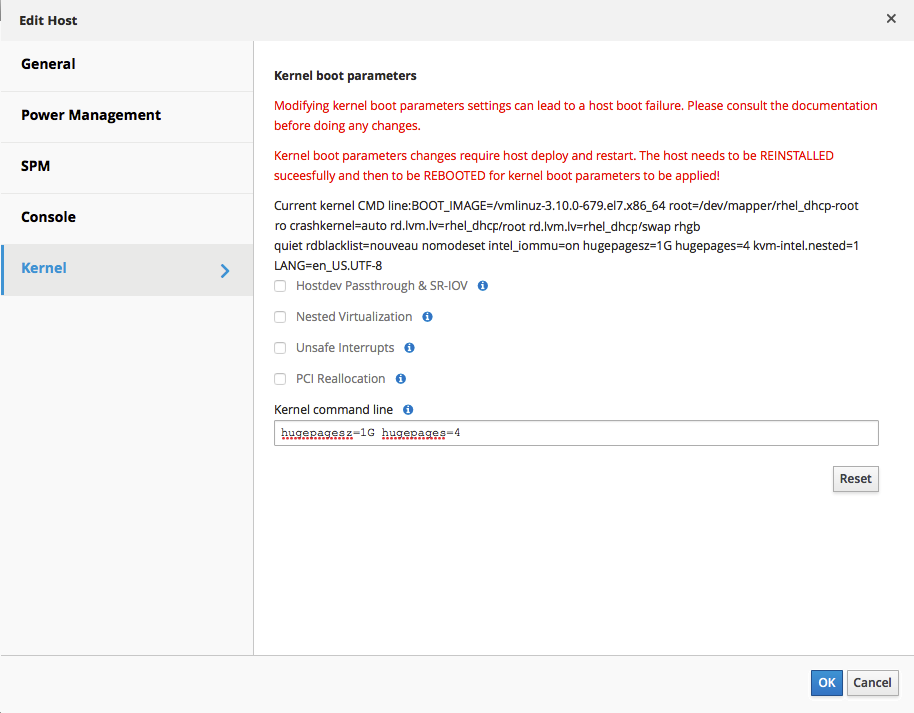Hugepages and oVirt
26 Jun 2017Introduction
Previously, we have talked about hugepages and how are they helpful and used in virtualization on the level of QEMU or libvirt. Let’s continue our tour de stack by oVirt’s shiny and new hugepages implementation.
oVirt
oVirt had upstream hook that allowed users to use custom property to request hugepage memory backing. The hook unfortunately has had multiple pitfalls: it only supported 2 MiB pages – making it x86_64 only (and still without 1 GiB hugepages). The hook is now gone and the functionality is merged within VDSM and engine code base - that makes hugepages a native, almost-first-class citizen in oVirt.
Setup
To enable hugepages backing, we must first allocate the hugepages. The code can allocate the pages right before VM starts, although It’s not exactly recommend that: as time goes, the chance to allocate the requested number of hugepages goes down due to memory fragmentation. The most sane way is therefore using kernel command line, and the most supported option is doing that through ovirt-host-deploy interface.

The process is as follows: Hosts -> Edit -> Kernel -> (set everything up, OK) -> Host Maintenance -> Reboot the physical machine -> Host Activate.
Configuration
When hugepages are available on the host, the only requirement is setting predefined property called hugepages, where the format is hugepages=size. Setting hugepages=2048 therefore sets 2 MiB hugepages, hugepages=1048576 yields 1 GiB hugepages. If the number does not match any available hugepage size, the default hugepages are used and warning is emitted to the /var/log/vdsm/vdsm.log. If the number is zero or negative (aka <= 0), the hugepages backing will be disabled – the same effect as removing the property.

Additionally, there are several new settings in /etc/vdsm/vdsm.conf:
- use_dynamic_hugepages – This is the option that enables dynamic allocation of hugepages. If enabled, VDSM can allocate extra hugepages to accommodate the VM without preallocating the pages. The algorithm prefers preallocated pages if those exist, and only allocates additional pages if necessary.
- use_preallocated_hugepages – If you expect VDSM to prefer preallocated pages, set this to
true. Actuallytrueby default. - reserved_hugepage_count – The interesting part. oVirt expects some preallocated pages to be used for different processes that just VMs. Example of such process is DPDK that assumes hugepages backing. If there is such process running on the host, set the
reserved_hugepages_countandreserved_hugepage_sizeaccordingly to accommodate it. - reserved_hugepages_size – See above.
Summary
So that’s it! Feel free to grab oVirt and play with hugepages! The feature should land in 4.2 builds, but you can already try it out by grabbing a master VDSM and adding custom hugepages=^[0-9]+$ property. These can be added by executing the following line on ovirt-engine host:
engine-config -s "UserDefinedVMProperties=hugepages=^.*$"
and you’re all set for experiments. The one thing to remember is that there is still (engine bug)[https://bugzilla.redhat.com/show_bug.cgi?id=1461476] to actually make scheduler work with hugepages. Right now, you may have to do some tweaking in that field to make things work. If you already have some experience with hugepages backed VMs or come across some interesting findings, feel free to share you experience in comments.